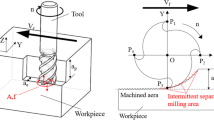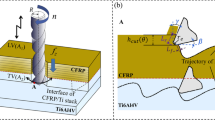Abstract
Titanium alloys (Ti6Al4V) have been widely applied in modern aerospace industry as structural components due to their superior mechanical and physical properties. Meanwhile, the countersinking technology of fastener hole is indispensable to the fastener assembly of countersunk screw. However, the conventional drilling and conventional countersinking (CC) process of Ti6Al4V hole will be difficult due to its low thermal conductivity, high chemical reactivity with many cutting tool materials, and high strength, which can easily cause the rapid tool wear, premature tool failure, unstable cutting process with chatter, and poor machining quality of hole surface. This has attracted wide attention of researchers. In recent years, the rotary ultrasonic vibration machining (RUVM) technology, as a novel machining method, has been found to be very effective in the machining process of difficult-to-cut materials like nickel alloys and Ti6Al4V. This paper first employed the RUVM technology to carry out the ultrasonic vibration countersinking (UVC) of Ti6Al4V, which was a new application of RUVM, and first presented a study on surface quality and tool life in UVC of Ti6Al4V. The experimental results indicated that compared with CC of Ti6Al4V, in UVC process, the maximum value of cutting force Fx and Fy as well as the thrust force Fz and torque Mz decreased by 56.5% and 35.2% as well as 20.6% and 12.8% respectively, the surface roughness of countersunk hole decreased by 41.2 to 42.3%, and the tool life of countersunk drill increased by three times; the cutting chatter of countersinking process was effectively suppressed, and the excellent surface integrity of countersunk hole was obtained in UVC. Moreover, the experimental results also proved that the UVC technology of Ti6Al4V was feasible and effective as well as the cutting effects of UVC were superior.
Similar content being viewed by others
References
Brewer WD, Bird RK, Wallace TA (1998) Titanium alloys and processing for high speed aircraft. Mater Eng Sci A 243:299–304
Ezugwu EO, Wang ZM (1997) Titanium alloys and their machinability—a review. J Mater Process Technol 68:262–274
Machado AR, Wallbank J (1990) Machining of titanium and its alloys—a review. Proc Inst Mech Eng 204:53–60
Yang X, Liu R (1999) Machining titanium and its alloys. Mach Sci Technol 3:107–139
Hinchcliffe M (2008) Characterisation of bond line porosity. University of New South Wales 1-2. http://ojs.unsw.adfa.edu.au/index.php/juer/article/view/139/95
Campbell FC (2006) Manufacturing technology for aerospace structural materials. Navy and The Boeing Company 492–532. https://www.elsevier.com/books/manufacturing-technology-for-aerospace-structural-materials/campbell-jr/978-1-85617-495-4
Schroeder PT (1998) Widening interest in twist drill. Modern Mach Shop 71:106–113
Cantero JL, Tardio MM, Cantelia JA, Marcos M, Miguelez MH (2005) Dry drilling of alloy Ti-6Al-4V. Int J Mach Tools Manuf 45:1246–1255
Altintas Y, Weck M (2004) Chatter stability of metal cutting and grinding. CIRP Ann 53:619–642
Roukema JC, Altintas Y (2007) Generalized modeling of drilling vibrations, part I: time domain model of drilling kinematics, dynamics and hole formation. Int J Mach Tools Manuf 47:1455–1473
Roukema JC, Altintas Y (2007) Generalized modeling of drilling vibrations, part II: chatter stability in frequency domain. Int J Mach Tools Manuf 47:1474–1485
Quintana G, Ciurana J (2011) Chatter in machining processes: a review. Int J Mach Tools Manuf 51:363–376
Pujana J, Rivero A, Celaya A (2009) Analysis of ultrasonic-assisted drilling of Ti6Al4V. Int J Mach Tools Manuf 49:500–508
Azarhoushang B, Akbari J (2007) Ultrasonic-assisted drilling of Inconel 738-LC. Int J Mach Tools Manuf 47:1027–1033
Liao YS, Chen YC, Lin HM (2007) Feasibility study of the ultrasonic vibration assisted drilling of Inconel superalloy. Int J Mach Tools Manuf 47:1988–1996
Dvivedi A, Kumar P (2007) Surface quality evaluation in ultrasonic drilling through the Taguchi technique. Int J Adv Manuf Technol 34:131–140
Baghlani V, Mehbudi P, Akbari J, Nezhad EZ, Sarhan AAD, Hamouda AMS (2016) An optimization technique on ultrasonic and cutting parameters for drilling and deep drilling of nickel-based high-strength Inconel 738LC superalloy with deeper and higher hole quality. Int J Adv Manuf Technol 82:877–888
Li Z, Zhang DY, Jiang XG, Wei Q (2017) Study on rotary ultrasonic-assisted drilling of titanium alloys (Ti6Al4V) using 8-facet drill under no cooling condition. Int J Adv Manuf Technol 90:3249–3264
Ma CX, Shamoto E, Moriwaki T, Zhang YH, Wang LJ (2005) Suppression of burrs in turning with ultrasonic elliptical vibration cutting. Int J Mach Tools Manuf 45:1295–1300
Ma CX, Shamoto E, Moriwaki T (2005) Chatter suppression with ultrasonic elliptical vibration based on energy principle. J China Ordnance 2:229–232
Ma CX, Ma J, Shamoto E, Moriwaki T (2011) Analysis of regenerative chatter suppression with adding the ultrasonic elliptical vibration on the cutting tool. Precis Eng 35:329–338
Zhang DY, Feng XJ, Wang LJ, Cheng DC (1994) Study on the drill skidding motion in ultrasonic vibration microdrilling. Int J Mach Tools Manuf 34:847–857
Zhang DY, Wang LJ (1998) Investigation of chip in vibration drilling. Int J Mach Tools Manuf 38:165–176
Wang LJ, Wang X, Zhao HF (2004) Effect of the cutting ratio on cutting forces and the drill life in vibration drilling. Int J Adv Manuf Technol 24:865–872
Shi HM (2003) New exploration of metal cutting theory and its application. Huazhong University of Science and Technology Press, Wuhan, 263–367
Li JZ (1993) Metal cutting dynamics. Zhejiang University Press, Hangzhou, 70–82
Altintas Y, Eynian M, Onozuka H (2008) Identification of dynamic cutting force coefficients and chatter stability with process damping. CIRP Ann 57:371–374
Hajikolaei KH, Moradi H, Vossoughi G, Movahhedy MR (2010) Spindle speed variation and adaptive force regulation to suppress regenerative chatter in the turning process. J Manuf Process 12:106–115
Li X, Zhang DY (2006) Ultrasonic elliptical vibration transducer driven by single actuator and its application in precision cutting. J Mater Process Technol 180:91–95
Zhou M, Hu LH (2015) Development of an innovative device for ultrasonic elliptical vibration cutting. Ultrasonics 60:76–81
Sanda A, Arriola I, Navas VG, Bengoetxea I, Gonzalo O (2016) Ultrasonically assisted drilling of carbon fibre reinforced plastics and Ti6Al4V. J Manuf Process 22:169–176
Dahnel AN, Ascroft H, Barnes S (2016) The effect of varying cutting speeds on tool wear during conventional and ultrasonic assisted drilling (UAD) of carbon fibre composite (CFC) and titanium alloy stacks. Procedia CIRP 46:420–423
Author information
Authors and Affiliations
Corresponding author
Additional information
Publisher’s note
Springer Nature remains neutral with regard to jurisdictional claims in published maps and institutional affiliations.
Highlights
(1) This paper first employed the rotary ultrasonic vibration machining (RUVM) technology to carry out the ultrasonic vibration countersinking (UVC) of Ti6Al4V, which was a new application of RUVM.
(2) This paper first presented a study on surface quality and tool life in UVC of Ti6Al4V.
(3) This paper first analyzed the cutting chatter reasons of conventional countersinking (CC) and chatter suppression mechanism of UVC.
(4) Compared with the CC of Ti6Al4V, the UVC can effectively suppress the cutting chatter defect, enhance the cooling and lubricating effects of cutting fluid, improve the cutting stability and surface quality of countersunk hole, reduce the cutting force and torque, decrease the surface roughness of countersunk hole and tool wear of countersunk drill, as well as prolong the tool life during the countersinking process.
Electronic supplementary material
(MP4 14726 kb)
Rights and permissions
About this article
Cite this article
Li, Z., Guo, H., Li, L. et al. Study on surface quality and tool life in ultrasonic vibration countersinking of titanium alloys (Ti6Al4V). Int J Adv Manuf Technol 103, 1119–1137 (2019). https://doi.org/10.1007/s00170-019-03572-x
Received:
Accepted:
Published:
Issue Date:
DOI: https://doi.org/10.1007/s00170-019-03572-x




